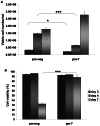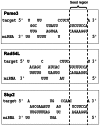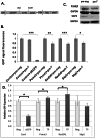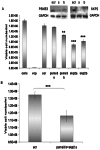MiR-7 triggers cell cycle arrest at the G1/S transition by targeting multiple genes including Skp2 and Psme3
- PMID: 23762407
- PMCID: PMC3675065
- DOI: 10.1371/journal.pone.0065671
MiR-7 triggers cell cycle arrest at the G1/S transition by targeting multiple genes including Skp2 and Psme3
Abstract
MiR-7 acts as a tumour suppressor in many cancers and abrogates proliferation of CHO cells in culture. In this study we demonstrate that miR-7 targets key regulators of the G1 to S phase transition, including Skp2 and Psme3, to promote increased levels of p27(KIP) and temporary growth arrest of CHO cells in the G1 phase. Simultaneously, the down-regulation of DNA repair-specific proteins via miR-7 including Rad54L, and pro-apoptotic regulators such as p53, combined with the up-regulation of anti-apoptotic factors like p-Akt, promoted cell survival while arrested in G1. Thus miR-7 can co-ordinate the levels of multiple genes and proteins to influence G1 to S phase transition and the apoptotic response in order to maintain cellular homeostasis. This work provides further mechanistic insight into the role of miR-7 as a regulator of cell growth in times of cellular stress.
Conflict of interest statement
Figures










Similar articles
-
Caffeic acid phenethyl ester induced cell cycle arrest and growth inhibition in androgen-independent prostate cancer cells via regulation of Skp2, p53, p21Cip1 and p27Kip1.Oncotarget. 2015 Mar 30;6(9):6684-707. doi: 10.18632/oncotarget.3246. Oncotarget. 2015. PMID: 25788262 Free PMC article.
-
BIS targeting induces cellular senescence through the regulation of 14-3-3 zeta/STAT3/SKP2/p27 in glioblastoma cells.Cell Death Dis. 2014 Nov 20;5(11):e1537. doi: 10.1038/cddis.2014.501. Cell Death Dis. 2014. PMID: 25412315 Free PMC article.
-
Skp2-mediated p27(Kip1) degradation during S/G2 phase progression of adipocyte hyperplasia.J Cell Physiol. 2007 Apr;211(1):101-11. doi: 10.1002/jcp.20915. J Cell Physiol. 2007. PMID: 17096381
-
p27(Kip1) signaling: Transcriptional and post-translational regulation.Int J Biochem Cell Biol. 2015 Nov;68:9-14. doi: 10.1016/j.biocel.2015.08.005. Epub 2015 Aug 14. Int J Biochem Cell Biol. 2015. PMID: 26279144 Review.
-
The role of Skp2 and its substrate CDKN1B (p27) in colorectal cancer.J Gastrointestin Liver Dis. 2015 Jun;24(2):225-34. doi: 10.15403/jgld.2014.1121.242.skp2. J Gastrointestin Liver Dis. 2015. PMID: 26114183 Review.
Cited by
-
Recent developments in miRNA based recombinant protein expression in CHO.Biotechnol Lett. 2022 Jun;44(5-6):671-681. doi: 10.1007/s10529-022-03250-1. Epub 2022 May 4. Biotechnol Lett. 2022. PMID: 35507207 Review.
-
Development and Growth of the Avian Pectoralis Major (Breast) Muscle: Function of Syndecan-4 and Glypican-1 in Adult Myoblast Proliferation and Differentiation.Front Physiol. 2017 Aug 8;8:577. doi: 10.3389/fphys.2017.00577. eCollection 2017. Front Physiol. 2017. PMID: 28848451 Free PMC article. Review.
-
MiR-7 in Cancer Development.Biomedicines. 2021 Mar 23;9(3):325. doi: 10.3390/biomedicines9030325. Biomedicines. 2021. PMID: 33806891 Free PMC article. Review.
-
Host-virus interaction: the antiviral defense function of small interfering RNAs can be enhanced by host microRNA-7 in vitro.Sci Rep. 2015 Jun 12;5:9722. doi: 10.1038/srep09722. Sci Rep. 2015. PMID: 26067353 Free PMC article.
-
F-box protein FBXO31 is down-regulated in gastric cancer and negatively regulated by miR-17 and miR-20a.Oncotarget. 2014 Aug 15;5(15):6178-90. doi: 10.18632/oncotarget.2183. Oncotarget. 2014. PMID: 25115392 Free PMC article.
References
-
- Ichimura A, Ruike Y, Terasawa K, Tsujimoto G (2011) miRNAs and regulation of cell signaling. FEBS J 278: 1610–8. - PubMed
-
- Cannell IG, Bushell M (2010) Regulation of myc by miR-34c: A mechanism to prevent genomic instability? Cell Cycle 9: 2726–30. - PubMed
-
- Lewis BP, Burge CB, Bartel DP (2008) Conserved seed pairing, often flanked by adenosines, indicates that thousands of human genes are microRNA targets. Cell 120: 15–20. - PubMed
Publication types
MeSH terms
Substances
LinkOut - more resources
Full Text Sources
Other Literature Sources
Research Materials
Miscellaneous

